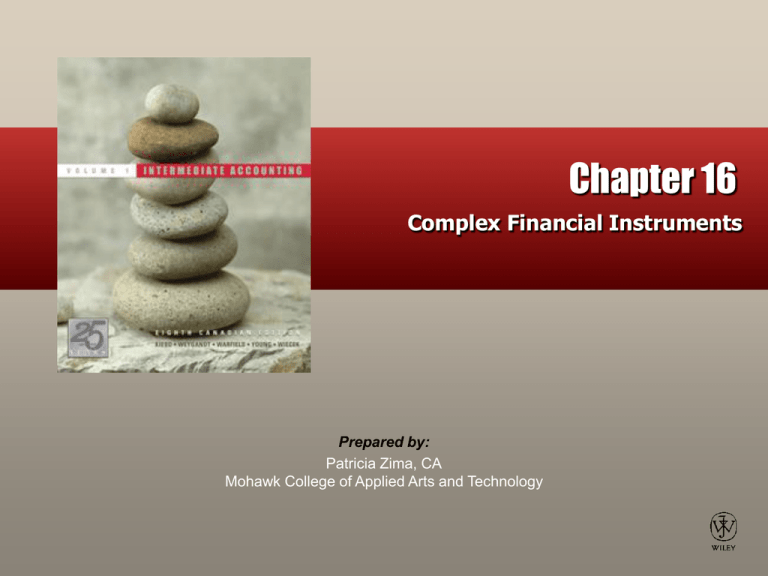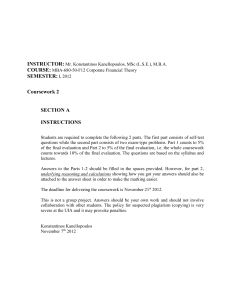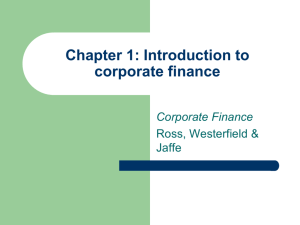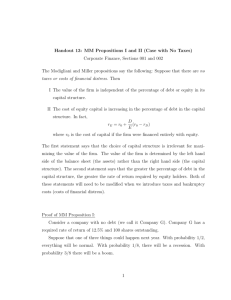
Chapter 16
Complex Financial Instruments
Prepared by:
Patricia Zima, CA
Mohawk College of Applied Arts and Technology
Complex Financial Instruments
Determining Whether
a Financial Instrument
is Debt, Equity or
Both
•Perpetual debt
•Callable/redeemable
preferred shares
•Debt with detachable
stock warrants
•Dealing with
uncertainty
•Interest/Dividends/
Gains/Losses
Basic Derivatives
Perspectives
•Analysis
•Understanding
derivatives: managing •International
risk
•Financial risks defined
•Using derivatives
•Recognition,
measurement and
presentation issues
•Options and warrants
•Forwards
•Futures
Stock
Compensation
Plans
•Types of Plans
•Direct awards of
stocks
•Stock options
revisited
•Compensatory
stock option plans
2
Complex Financial Instruments
Appendix 16A – Hedging
•Derivatives used for
hedging
•Separating the act of
hedging risks from the
decision to use hedge
accounting
•Qualifying hedge criteria
•Fair value hedges
•Cash flow hedges
•Disclosures
Appendix 16B – Stock
Compensation PlansAdditional Complications
•Stock appreciation
rights plans
•Performance type plans
Appendix 16C – Fair
Value Measurement
•Options pricing
models
•Discounted cash
flows
•International
3
Debt, Equity or Both?
Hybrid/combined instruments:
• Have characteristics of both debt and equity
– Examples:
• Debt with detachable warrants
• Redeemable preferred shares
• Are they debt? Are they equity?
• Are they a bit of both?
• Presentation issue requires that the economic
substance of the instrument be examined to
determine reporting classification
4
Definitions Revisited
• Financial liability is any liability that is a
contractual obligation to do either of the
following:
1. Deliver cash or another financial asset to
another party or
2. Exchange financial instruments with
another party under conditions that are
potentially unfavourable
• An equity instrument is any contract that
evidences a residual interest in the assets of
an entity after deducting all of its liabilities
5
Presentation and Classification
• CICA Handbook Section 3863
• From the perspective of the issuer, is it a
financial liability or equity instrument?
• You may have to split out the equity
component of certain financial instruments
6
Measurement Issues
•
•
•
Financial liabilities that are held for trading are
valued at fair value
Other financial liabilities are measured at
amortized cost using the effective interest
method
Hybrid/Combined instruments:
– Economic value stems from both the debt
component and the equity component
– Two measurement tools:
1. Incremental (residual) method
2. Proportional method
7
Perpetual Debt
• The instrument is never repaid
• Should perpetual debt be classified
as debt? or as equity?
• Legally, it is debt, but economically
speaking, it is similar to equity
• The question is answered by
examining the source of the value of
the instrument
8
Perpetual Debt
• Value for a perpetual debt stems from the
value of the interest payments
– Interest, not the principal must be paid
• Therefore, by definition, perpetual debt is a
financial liability
– Due to the legal obligation to pay interest
(despite the fact that no obligation exists to
pay the principal), unlike shares where
there is no legal obligation to pay dividends
9
Callable/Redeemable Preferred
Shares
• Term, or mandatorily redeemable preferred
shares
– Shares that will be redeemed by the
issuing company
• This type of instrument is a financial liability
– Obligation exists for the company to pay
cash when the shares are redeemed,
although legally they are equity
10
Callable/Redeemable Preferred
Shares
• Many small businesses want to hand the
company over to their children
• One way of doing this that minimizes taxes is
through the use of redeemable preferred shares
(sometimes referred to as high/low preferred
shares)
• Treating these redeemable preferred shares as
debt makes the company look highly debt
leveraged – but in fact, the shares will normally
not be redeemed in the short - term
• The CICA allows qualifying small businesses to
use differential reporting (i.e. treat these
particular instruments as equity)
11
Debt with Detachable Stock
Warrants
• Detachable warrant
– Option to buy common shares at a fixed
price (exercise price)
– Warrant available only for a limited time
(exercise period)
– Warrants traded on public markets
• CICA Handbook, Section 3863.A2 defines
warrants and options as equity instruments
• Therefore, the financial instrument is part
debt and part equity
12
Debt with Detachable Stock
Warrants
•
How much of the value of the instrument is
debt and how much is equity?
• Debt portion relating to the note, bond or
financial liability portion
• Equity portion relating to the warrant or
equity instrument portion
• Two measurement options
1. Proportional method
2. Incremental or residual method
13
Proportional Method
• Market value for the pure debt component is
established
– Can use PV of cash flows for similar debt
(discounting using market rate)
• Warrant/option portion value determined
using options pricing model or market values
• Values are then assigned to the respective
debt and equity components on a pro-rata
basis
14
Incremental or Residual Method
• Only one component (debt or equity) is
valued
– Whichever is easier to value
• Remaining component is assigned the
remaining value
15
Triggering Events
• Certain preferred shares are redeemable or
retractable if specific events occur (e.g. if the
company’s shares are delisted from a stock
exchange)
• If the triggering event is probable or likely when
the instrument is first recognized, recognize as a
liability (contingency accounting comes into play)
• The classification as either debt or equity remains
the same until the triggering event occurs or fails
to occur - a new assessment is made
16
Settlement Options
• Some debt instruments allow the issuing company to
repay the debt with either cash or shares
• These instruments have the legal form of debt but
economic substance may be other
• The interest portion is debt and the principal portion
is equity (since no obligation to pay cash)
• However, if there is an obligation to pay a fixed dollar
amount which may be settled using cash or a
variable number of shares, then total instrument
recognized as debt
17
Retractable Preferred Shares
• Retractable preferred shares give the holder
the option to force the company to redeem
the shares
• The redemption is beyond the company’s
control i.e. there is little or no discretion to
avoid paying the cash
• Since the company has a contractual
obligation to deliver cash, the preferred
shares represent a financial liability
18
Convertible Debt
• Bonds that are convertible to other forms of
securities (e.g. common shares) during a
specified period of time
• Combines the benefits of a bond (interest
payments, principal repayment) with the
privilege of exchanging the bond for shares at
the bondholder’s option
• Once the bond is converted, all interest and
principal no longer payable
19
Convertible Debt
Issued for two main reasons
1. Corporation can raise equity capital without
giving up ownership control
2. It can also achieve equity financing at a lower
cost
• Conversion feature allows the corporation to
offer the bond issue at a lower coupon
• Conversion feature provides investor with
an opportunity to own equity - generally
results in the investor accepting a lower
coupon rate than with non-convertible debt
20
Convertible Debt – Accounting
Issues
•
The reporting of convertible debt and the
conversion feature result in three issues:
1. Reporting at the time of issuance
2. Reporting at the time of conversion
3. Reporting at the time of retirement
21
Reporting at the Time
of Issuance
•
On issue date, part of the proceeds are
allocated to liability and part to equity
• This reflects the nature of the security—
since a convertible debt is part liability (the
obligation to pay cash) and part equity (the
right to acquire shares)
• The amounts allocated to liability and equity
are determined by using either:
1. The Incremental Method
2. The Proportional Method
22
The Incremental Method
•
•
The value of the most easily measured
component is determined and allocated to that
component
– Debt generally the easier component to
value
Remainder of the proceeds become the value
of the other component
23
The Incremental Method—
Example
Given:
• $1,000,000 par value, 6% convertible bonds
• Similar bonds (without conversion feature) have
a 9% interest rate
• Each $1,000 bond convertible to 250 common
shares (current market price of $3)
What portion of the proceeds are allocated to Bond
Liability, and what portion to equity?
24
The Incremental Method—
Example
Total proceeds for the bond issue
($1,000,000 * at par value)
=
$ 1,000,000
Fair value of the liability without the
conversion option PV at 9%) =
Residual allocated to option
$
$
924,061
75,939
25
The Proportional Method
• When values for both the liability and equity
components are known or determinable
Given:
• $1,000,000 par value, 6% convertible bonds
• Similar bonds (without conversion feature)
have a 9% interest rate
• Each $1,000 bond convertible to 250
common shares (current market price of $3)
26
The Proportional Method
Present value (fair value) of the bonds
Fair value of conversion rights
Using an option pricing model
Aggregate fair market value
Cash
$924,061 92.7%
$ 72,341
7.3%
$996,402 100%
1,000,000
Bonds Payable
927,000
Contributed Surplus -Conversion rights 73,000
Note that in this case fair values for both the liability
and the conversion feature are clearly given
27
Reporting at Time of Conversion
•
Main issue is determining the amount at which
to record the securities which are being
exchanged
• Two approaches available
1. Book value approach
• No gain or loss recognized on conversion
• Most common approach
2. Market value approach
• Gain or loss on conversion can occur
28
Book Value Approach
• When market price of bonds or shares not
known
– Book Value of the bonds and conversion
rights used to record the conversion
• The basis for this method is that a “swap” or
exchange of security has taken place
• The values were established when the bonds
were originally issued and therefore should
not be changed, as there was a contract in
place
29
Book Value Approach
• Example continued - assume that the
unamortized discount portion is $14,058
(therefore, book value of Bonds Payable is
1,000,000 – 14,058 = 985,942)
• The entry to record the conversion would be
as follows:
Bonds Payable
985,942
Contributed Surplus -Conversion rights 73,000
Common Shares
1,058,942
30
Induced Conversion
• When the corporation wants to entice or
induce the bondholders to convert their bonds
into shares
• Additional consideration – the “sweetener” –
offered to the bondholders to convert (cash,
common shares, etc.)
• The inducement is allocated between the
debt and equity components based on fair
value at time of conversion
31
Induced Conversion
• Assume Bond Corp. offers an additional cash
premium of $15,000, when carrying amount of the
debt is $972,476 and bond’s fair value at date of
conversion is $981,462
• $981,462 - $972,476 =$8,986 (debt retirement cost)
Bonds Payable
972,476
Expense – Debt Retirement
8,986
Contributed Surplus – Conversion rights 75,939*
Retained Earnings (15,000 – 8,986)
6,014
Common Shares
1,048,415
Cash
15,000
* Calculated previously using Incremental Method
32
Reporting at the
Time of Retirement
• Treated the same as debt retirement from
Chapter 14 for non-convertible bonds
– Clear any outstanding premiums,
discounts, bond issue costs, interest
accrued to bondholders
– The conversion rights account must be
reallocated
– Equity components remains in Contributed
Surplus
33
Reporting at the
Time of Retirement
• Assume that Bond Corp. decides to retire the
convertible debt early and offers the
bondholders $1,070,000 cash
Bonds Payable
972,476
Expense – Debt Retirement
8,986
Contributed Surplus – Conversion rights 75,939
Retained Earnings
12,599
Cash
1,070,000
34
Convertible Preferred Shares
• Convertible preferred shares considered equity
– Convertible debt considered liability and equity
• At the time of issuance, no allocation between
debt and equity components
• Exception is redeemable preferred shares
• When conversion occurs the book value
method is used
– Deemed the exchange of one equity for another
equity instrument
35
Interest, Dividends, Gains/Losses
• The related interest, dividends, gains, and
losses must be consistently treated as the
financial instrument they relate to
• For example, a term preferred share is
presented as a liability and
• The related dividends would be recorded as
interest expense (or dividend expense) and
charged to the income statement (instead of
Retained Earnings)
36
Derivatives - Definitions Revisited
• Financial instruments: contracts that create
both a financial asset for one party and a
financial liability or equity instrument for the
other party
• Primary financial instruments: include most
basic financial assets and financial liabilities,
such as receivables and payables, and
equity instruments, such as shares
37
Derivatives
•
Derivatives are financial instruments that
create rights and obligations, that transfer
financial risk from one party to the another
party
•
Derivatives have the following characteristics:
1. Their value changes in response to the
underlying instrument (the “underlying”)
2. They require little or no initial investment
3. They are settled at a future date
38
Derivatives
•
Derivative instruments include:
1. Forwards
2. Futures
3. Options
•
Example: Stock Options
– The stock is the “underlying”
– If the share price goes up, the option is
worth more;
– If the share price goes down, the option
may become worthless
39
Financial Risks Defined
•
Derivatives used to manage financial risks:
1. Credit Risk
– Risk to one party that the other party will fail to
meet an obligation
2. Liquidity Risk
– Risk of not being able to meet own financial
obligation
3. Market Risk
– Risk that fair value or future cash flows of a
financial instrument will fluctuate due to changes
in market price (includes currency risk, interest
40
rate risk, and other price risk)
Derivatives
•
Used by
1. Producers and Consumers
• Lock in future revenues or costs
2. Speculators and Arbitrageurs
• Maintain market liquidity
• Additional motivations to use derivatives
– Manage interest rate volatility
– Manage foreign exchange rate volatility
41
Derivative Reporting
•
•
CICA Handbook Sections 3855, 1530 and 3865
Basic principles for these new sections:
1. Financial instruments (including financial
derivatives) and non-financial derivatives should
be reported in financial statements
2. Derivatives should be reported at fair value (with
gains and losses booked through net income)
3. Only items that are assets or liabilities should be
reported in the financial statements
4. Special accounting is used for items that have
been designated as being part of a hedging
relationship
42
Derivative Instruments
•
Options
1. Call Option
•
Holder has the right, but not the
obligation, to purchase the “underlying” at
a preset (strike or exercise) price
2. Put Option
•
Holder has the right to sell the
“underlying” at a preset price
43
A Framework for Options
Written
Call – right to buy
Put – right to sell
Sell option for $:
Sell option for $:
Transfer rights to buy
shares/underlying
Transfer right to sell
shares/underlying
Purchased Pay $ for option:
Obtain right to buy
shares/underlying
Pay $ for option:
Obtain right to sell
shares/underlying
44
Derivative Accounting - Example
Given:
• Call option entered into January 2, 2007
• Option expires April 30, 2007
• Option to purchase 1,000 shares at $100 per
share
• Share market price on January 2, 2007 is $100
per share
• Option is purchased for $400 (Option Premium)
• Share price on March 31st is $120 per share
45
Accounting for Derivatives
Option Price Formula
Option
Intrinsic
=
Premium
Value
Market Price less
Strike (Exercise)
Price
Option
Premium
+
Time
Value
Option Value
Less
Intrinsic Value
= ($100 - $100) + ($400 - $0)
Journal Entries
46
Accounting for Derivatives
January 2 (acquisition date)
Derivative – trading
Cash
400
400
March 31 (to record change in value of option)
Derivative – trading
19,700*
Gain
Assume options are trading at $20,100
*(20,100 – 400)
April 1 (settlement of option)
Cash
Loss
Derivatives - Trading
Time Value = ($400 - $100)
19,700
20,000
100
20,100
47
Accounting for Derivatives
Derivatives-trading
Gain – 03/31/07
400
19,700
19,700
Derivatives-trading
April 1, 2007
20,100
20,100
20,100
Reported on
March 31st
Balance Sheet, with
Call Option balance
Value Increase 19,700
Settle option
100
Net Income
19,600
48
Forwards
• Under a forward contract, parties each commit
upfront to do something in the future
• Example: Assume on January 2, 2007, Abalone
Inc. agrees to buy $1,000 in U.S. currency for
$1,150 in Canadian currency in 30 days from
Baird Bank
• Abalone has the right to any increases in value
of the underlying (U.S. dollars), and an
obligation exists to pay a fixed amount of
$1,150 by a specified date
• This forward contract transfers the currency risk
inherent in the Canada-U.S. exchange rate
49
Forwards
• The value of the forward contract will vary depending
on interest rates as well as on the spot prices (the
current value) and forward prices (future value) for the
U.S. dollar
• If the U.S. dollar appreciates in value, in general, this
particular contract will have value to Abalone
• The forward is remeasured at fair value
• For example, if the fair value of the contract is $50, on
January 5, 2007, the journal entry is:
Derivative-trading
50
Gain
50
50
Stock Compensation Plans
•
•
•
A form of stock warrant — a stock option
Provides the employee with an opportunity to
purchase shares at a given price, within a
specified period of time
Two accounting issues associated with stock
compensation plans
1. Determination of compensation expense
2. Periods of allocation for compensation expense
amounts
51
Types of Compensation Plans
1.
2.
3.
4.
Direct stock awards
Compensatory stock option plans (CSOP)
Stock appreciation rights plans (SAR)
Performance-type plans
52
Direct Stock Awards
• Non-monetary reciprocal transaction
– Little or no cash involved
– Two-way transaction (the company gives
something up (shares) and gets the
employee’s services in return)
• Recorded at fair value of the shares
53
Stock Options - Important
Dates
Work
start date
Grant
date
Vesting
date
Exercise
date
Expiration
date
Options
are
granted to
employee
Date that
employee
can first
exercise
options
Employee
exercises
options
Unexercised
options
expire
54
Uses of Stock Options
Stock Options
Issued by other e.g.
Financial institutions
Issued by the company
CSOP ESOP
Not traded on
Exchange since must
Be employee to hold
Other
Warrants
Not traded on
Exchange since
Rights usually not
transferable
Often exchange
traded
55
Compensatory vs. NonCompensatory Plans
Stock Options
Compensatory
CSOP
Operating transactions
Income
Statement
Non-compensatory
ESOP
Capital transactions
Shareholders’
Equity
56
Compensatory vs. NonCompensatory Plans
Factors to determine if a plan is compensatory
1. Option terms
• Non-standard terms implies compensatory
2. Discount from market price
• Implies compensatory
3. Eligibility
• If available to only a certain group of
employees (i.e. management)
57
Non-Compensatory - Example
• Fanco Limited set up an ESOP that gives
employees the option to purchase shares for $10
per share
• On January 1, 2008, employees purchase 6,000
options for $6,000:
Cash
6,000
Contributed Surplus-Options
6,000
• If employees exercise all 6,000 options:
Cash (6,000 x $10)
60,000
Contributed Surplus-Options
6,000
Common Shares
66,000
58
Options: Allocating Compensation
Expense
is determined as of the
measurement date
Compensation Expense
and is allocated over
the service period
• The service period is the period benefited by
employee’s service
• It is usually the period between the grant date
and the vesting date
59
Compensation Expense - Example
• A company grants options on January 1, 2009 to the
company’s executives to purchase 2,000 shares
• The option price per share is $60, and the market
price is $70 per share when options are granted
• The fair value, determined by an option pricing
model, results in compensation expense of $220,000
• Assuming expected period of service is two years,
journal entries at year end for 2009 and 2010:
Compensation Expense
110,000
Contributed Surplus – Stock Options 110,000
($220,000 / 2)
60
Compensation Expense - Example
• If 20% or 2,000 of the 10,000 options were exercised
on June 1, 2012, journal entry is:
Cash (2000 x $60)
120,000
Contributed Surplus–Stock Options
(20% x $220,000)
44,000
Common Shares
164,000
• If the remaining stock options are not exercised
before their expiration date, journal entry is:
Contributed Surplus–Stock Options 176,000
Contributed Surplus-Expired Options 176,000
(80% x $220,000)
61
Compensation Plan Disclosure
• Following is fully disclosed
– Accounting policy used
– Description of the plans and modifications
– Details of number and values of options
issued, exercised, forfeited, and expired
– Description of assumptions and methods used
to determine fair values
– Total compensation cost include in net
income/contributed surplus, and
– Other (CICA Handbook, Section 3870.67)
62
COPYRIGHT
Copyright © 2007 John Wiley & Sons Canada, Ltd.
All rights reserved. Reproduction or translation of
this work beyond that permitted by Access Copyright
(The Canadian Copyright Licensing Agency) is
unlawful. Requests for further information should be
addressed to the Permissions Department, John
Wiley & Sons Canada, Ltd. The purchaser may make
back-up copies for his or her own use only and not
for distribution or resale. The author and the
publisher assume no responsibility for errors,
omissions, or damages caused by the use of these
programs or from the use of the information
contained herein.
63







